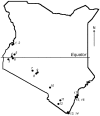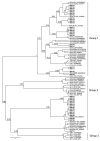Detection of novel SARS-like and other coronaviruses in bats from Kenya
- PMID: 19239771
- PMCID: PMC2681120
- DOI: 10.3201/eid1503.081013
Detection of novel SARS-like and other coronaviruses in bats from Kenya
Abstract
Diverse coronaviruses have been identified in bats from several continents but not from Africa. We identified group 1 and 2 coronaviruses in bats in Kenya, including SARS-related coronaviruses. The sequence diversity suggests that bats are well-established reservoirs for and likely sources of coronaviruses for many species, including humans.
Figures


References
-
- Che XY, Hao W, Qiu LW, Pan YX, Liao ZY, Xu H, et al. Antibody response of patients with severe acute respiratory syndrome (SARS) to nucleocapsid antigen of SARS-associated coronavirus [in Chinese]. Academic Journal of the First Medical College of PLA. 2003;23:637–9. - PubMed
Publication types
MeSH terms
Substances
LinkOut - more resources
Full Text Sources
Miscellaneous
